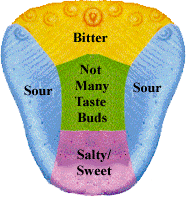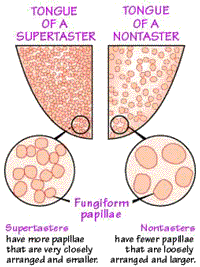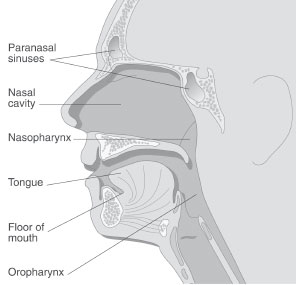Pugman1943
Well-Known Member
Sounds simple, right? Well it depends. Taste is defined as “form of direct chemoreception and is one of the traditional five senses. It refers to the ability to detect the flavor of substances such as food, certain minerals, and poisons.” But when taste partners with the sense of smell… that is how the brain perceives flavors. So we’re really talking about two senses here: taste and smell. But from here on out we’ll just lump together into “taste”, ok?
There are two and half ways to taste a cigar. Yes, two and a half. The first is using your tongue (taste). The second is using your sinuses (smell) and the half is on the finish (like with wine). Taking the time to be aware of all of your tasting “tools” will help you further enjoy cigars!
So let’s start with the tongue. The tongue, to me, is actually kind of limited. It can only detect sweet, sour, salt, bitter and umami. Let’s tackle these one by one.

The traditional tongue map... which turned out to be a myth
So that’s it for the tongue? Well, not really. The tongue can of also pick up things like temperature, metallic-ness and dryness – handy things when smoking cigars. There are also supertasters – folks that have a heightened sense of taste above the average person. This is due to, simply put, having more taste buds than the average person. This is most common in Latin America (no surprise there), Asia and Africa. Only 25% of people of European descent are supertasters.


Let’s move on to the sinuses, nose and olfactory senses. Olfaction, or the sense of smell, contributes to our perception of flavor. While our tongue can detect only 5 distinct qualities, the olfactory system can detect hundreds. So when you smoke a cigar, you should smell it, right? Now, you can smell the smoke from the cigar in the air, but that’s the aroma and does not contribute to the flavor. You can smell the cigar when the smoke is in your mouth. But to REALLY smell the smoke, you need to exhale through your nose, bringing the smoke up through your sinuses – this is often referred to as retro-hale. If you’ve never done this, then you’ve been selling yourself short and missing out on a lot of cool flavors and complexity. This is the way to smoke a cigar.
The “finish” is another key part in enjoying a cigar. The finish is a fancy term for aftertaste. Aftertaste is the persistence of flavor long after the substance has passed over the taste receptors. As far as cigars are concerned, the finish should be enjoyable and the longer the flavors remain the better. For some reason certain flavors from cigars are more prominent on the finish than others, like coffee, cocoa and licorice.
Here are a few other important facts, statements and suggestions about cigar tasting:
From the article in Cigar Inspector.
http://www.cigarinspector.com/#facebook
There are two and half ways to taste a cigar. Yes, two and a half. The first is using your tongue (taste). The second is using your sinuses (smell) and the half is on the finish (like with wine). Taking the time to be aware of all of your tasting “tools” will help you further enjoy cigars!
So let’s start with the tongue. The tongue, to me, is actually kind of limited. It can only detect sweet, sour, salt, bitter and umami. Let’s tackle these one by one.
- “Bitter” traditionally is used to describe something unpleasant, but in combination of other flavors it is very nice. Flavors that can fall under bitter are: coffee, chocolate and citrus.
- “Sour” is different than bitter in that sour detects acidity. Cigars generally don’t fill those sour taste receptors, but an improperly aged cigar can taste sour.
- “Sweet” is considered a pleasurable taste sensation, but given the fact that two variant taste receptors have to be activated for the tongue to detect sweet, this is rarely achieved while smoking a cigar, unless sugar is added artificially to the tip of a cigar.
- “Salt” is activated in the presence of Sodium or other alkali metals. Interestingly, saltiness is famously picked up in Cuban cigars, and Cuban soil has a high concentration of lithium (an alkali metal close to Sodium). Who knew there was so much science in cigars?
- “Umami” means meaty or savory. This receptor is activated by amino acids, basically things high in protein like meats and cheeses.

The traditional tongue map... which turned out to be a myth
So that’s it for the tongue? Well, not really. The tongue can of also pick up things like temperature, metallic-ness and dryness – handy things when smoking cigars. There are also supertasters – folks that have a heightened sense of taste above the average person. This is due to, simply put, having more taste buds than the average person. This is most common in Latin America (no surprise there), Asia and Africa. Only 25% of people of European descent are supertasters.


Let’s move on to the sinuses, nose and olfactory senses. Olfaction, or the sense of smell, contributes to our perception of flavor. While our tongue can detect only 5 distinct qualities, the olfactory system can detect hundreds. So when you smoke a cigar, you should smell it, right? Now, you can smell the smoke from the cigar in the air, but that’s the aroma and does not contribute to the flavor. You can smell the cigar when the smoke is in your mouth. But to REALLY smell the smoke, you need to exhale through your nose, bringing the smoke up through your sinuses – this is often referred to as retro-hale. If you’ve never done this, then you’ve been selling yourself short and missing out on a lot of cool flavors and complexity. This is the way to smoke a cigar.
The “finish” is another key part in enjoying a cigar. The finish is a fancy term for aftertaste. Aftertaste is the persistence of flavor long after the substance has passed over the taste receptors. As far as cigars are concerned, the finish should be enjoyable and the longer the flavors remain the better. For some reason certain flavors from cigars are more prominent on the finish than others, like coffee, cocoa and licorice.
Here are a few other important facts, statements and suggestions about cigar tasting:
- Every cigar does not taste the same to everyone.
- The wrapper accounts for most of a cigar's flavor but can range anywhere from 20-80% of the total flavor from the smoke.
- What you drink can change the flavors and intensity of what you are smoking. I like drink water the first time I try a cigar to get the flavors “unfiltered”.
- If you are smoking multiple cigars, try drinking apple juice in between to cleanse your palate.
- If you are smoking multiple cigars, smoke the mildest first.
- Try not to overwhelm your palate. Smoking very strong cigars all the time makes it harder for you to enjoy mild or medium cigars.
- A cigar's aroma (the inhale) can have different qualities than the exhale (or retro-hale).
- Don't hesitate to use our Cigar Flavors Wheel which can help you define flavors you're experiencing.
From the article in Cigar Inspector.
http://www.cigarinspector.com/#facebook

